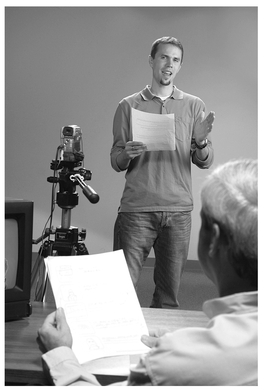26
Recruiting Talent
Tad Rose

Figure 26-1
Talent matters. Be it on or off screen, good performers can help take your project to the next level. Therefore, it is well worth the time for any producer to find ways of attracting the best talent available.
Sometimes casting is as simple as twisting your kid brother’s arm, but most productions require considerable attention to the process of recruiting. Consider a request from the local school district for you to produce an orientation video. The goal is to prepare freshmen for the high school experience and to promote a safer school environment by presenting students with a variety of conflict resolution strategies. Such a project may well require talent in the form of a host for on-camera interviews, a narrator to communicate important facts and statistics, teachers and counselors for expert commentary and actors to dramatize campus conflicts. Each role requires a particular skill and the right casting choices.
Determine Your Needs
A script or detailed outline is essential for determining your talent requirements. From it, you can then prepare a cast list. This list should include all significant speaking and non-speaking roles, as well as a brief description of what each role requires. For example, should the host be an adult or a teenager, male or female, clean cut or rugged? If you have a clear idea what you’re looking for, it will be easier to find it.
Once you’ve identified your needs, you’re ready to start recruiting talent. It’s up to you (and your budget) whether you cast professionals, amateurs or your own mother (like director Martin Scorsese), but it’s important to find the best available candidate for the role. Remember that while a Hollywood cast may be beyond your budget, professional quality performances needn’t be. Talent grows everywhere.
Sources of Talent
Local theater troupes, college drama departments, churches, high schools, comedy clubs and community groups are all excellent sources of talent. To tap them, contact the person in charge, explain your

Figure 26-2 Local theater troupes, college drama departments, high schools, comedy clubs and community groups are all excellent sources of talent.
project, and ask if they can recommend anyone. Maybe they know the perfect candidate. If not, perhaps they’ll allow you to post a flier announcing your audition. If you do post fliers, make sure you do it at least a couple of weeks ahead of any auditions and be sure to provide adequate information, including the type of production, roles being cast and contact number. You can also place an ad in the local paper or on an internet bulletin board. In addition, of course, tell all your friends. Cast your net wide and you are more likely to find the talent you’re after.
Auditions
There’s no hard and fast rule about auditioning. Some producers have all candidates show up at the same time (cattle call), others schedule individual appointments. You could simply ask candidates to send in a demo reel. I know of one producer looking for voice over talent who even had candidates call and leave their audition on his answering machine. However, if you are serious about finding the right talent, it’s best to arrange face-to-face auditions and use the tapes and other demos as screeners.
Most producers provide candidates with audition materials. This can be actual dialog or narration from your script or material from another source that will allow you to evaluate their abilities. You can also allow the actors to use their own audition piece. This isn’t really recommended, however, since their choice may have little relation to your project and their polished performance will not give you an idea of what it is like to work with this person on the set.
If you cannot provide candidates with audition material in advance, give them a few minutes to prepare before you put them in the hot seat. Cold readings (auditions without prior exposure to the material) rarely reveal the range and ability of your candidates.
Allow about 15 to 20 minutes per audition with five-minute breaks in between. This will give you adequate time to interview the candidates and jot down any notes between auditions. Make sure you ask about their background and experience. Show interest and be positive: This will relax your candidate and result in a better performance. It’s also a good idea to record the entire audition. This will give you the chance to review the candidates later and evaluate their strengths and weaknesses on camera.
Be sure you explain what the role entails, including the number of shooting days and any compensation your are able to offer. Don’t be discouraged if your budget doesn’t allow you to pay your talent. Many aspiring performers will be happy to work for nothing more than a credit and a copy of the finished piece for their portfolio. Nevertheless, if you can pay a token sum, you should. It recognizes the contribution your actors are making and encourages them to take a professional approach to the project.
Evaluating Talent
For our hypothetical video, we need both an on-screen host and a voice over artist to do narration. The requirements for each are different. For the host, you must consider both appearance and vocal quality, but it is strictly vocal characteristics (such as volume, diction, rate, pitch, tone and timbre) that matter in narration, since that performer will never be seen.
Casting is subjective. The goal is to match the role with the best available talent and

Figure 26-3 Recorded auditions—it’s a good idea to record the entire audition. This will give you the chance to review the candidates later and evaluate their strengths and weaknesses on camera.
that’s not always easy. Many factors besides ability will influence your final choices. Determining the availability of your talent is a pragmatic, but important, consideration. Someone may be perfect to host the program, but if she is only available Sunday evenings after six, you will probably have to keep looking. It’s also a good idea to gauge the motivation of your prospects as well, especially if they are working “for credit” (“volunteers”). Enthusiastic, paid performers will be more likely to show up on time and ready to perform, than those you’ve had to beg and cajole.
For acting roles, you may want to consider typecasting. Unless you’ve discovered a young Brando or De Niro, it’s easier for actors to play characters with traits and characteristics close to their own. If the kid who mows your lawn has a bit of an attitude, maybe he would be perfect to play the bully in your conflict dramatization. Casting close to type will often result in performances that are more natural, especially from inexperienced actors.
Getting the Best Performance
No matter whom you cast, whether best friend or a complete stranger, it is up to you to get the best performances possible. The ability to elicit good performances is the mark of a truly skilled director It’s not easy. Approaches range from the autocratic to the collaborative. However, in my experience working with both novice and veteran performers alike, I have found one thing improves performances every time: encouragement. Pointing out what was good about a given take before suggesting ways to improve it, will build a feeling of confidence and security in your actors. If they know you have confidence in them, their work may lift your production to an entirely new level.
Summary
Be willing to look outside your immediate circle of friends to find the best available talent for your project. List your casting requirements, then audition to find the right person for each part. Be prepared to provide clear, concise direction to your performers. Create a positive, collaborative atmosphere on the set. And, of course, never forget to provide lunch.

